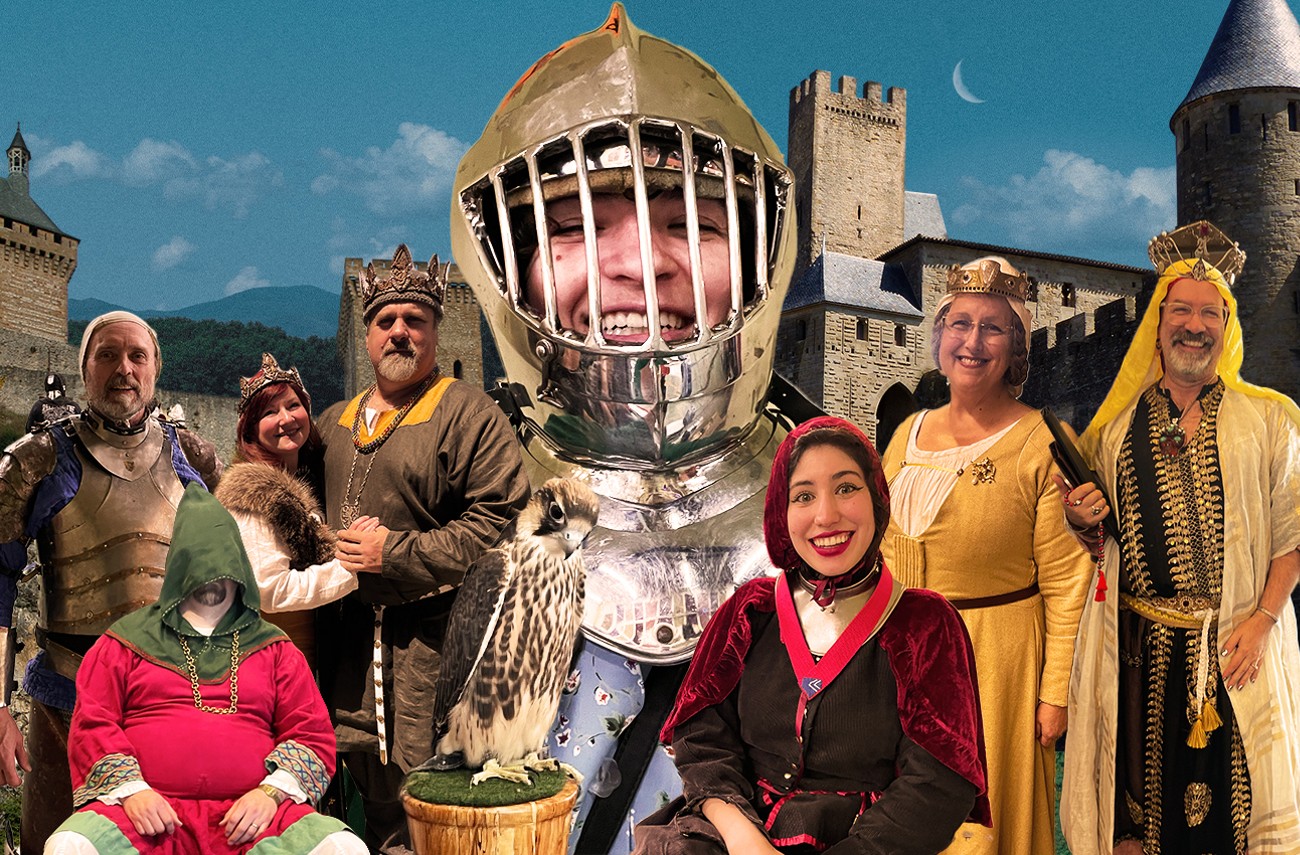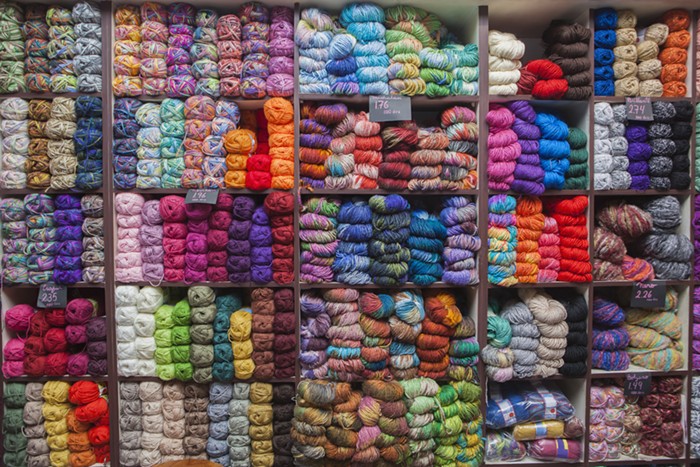Fremont’s KapKa Cooperative Elementary School smelled of rubber, stale sweat, and nostalgia. The smack of duct-tape-wrapped rattan swords on real steel armor reverberated across the room. Fighters thrust swords and sidestepped blows across faded three-point lines.
Every Monday in this gym, fencers, fighters, and rapier-wielders gather for combat practice. On different Mondays, dancers learn the steps to Renaissance-era jigs. On certain Wednesdays, scribes meet at Third Place Books in Ravenna. You’ll find bards, heralds, jousters, seamstresses, cooks, and so many more in this gym and at events around the region, including fairs, camp-outs, tournaments, and staged wars. Anyone is welcome so long as they stick to the rules: Keep it pre-17th century.
This is the Society for Creative Anachronism (SCA), a group of people interested in what they call “living archaeology.” They learn the practical skills and culture of the pre-modern era, and then they put them into action.
You see, if you live in the Seattle area, you actually live in the Barony of Madrone (muh-dron-uh) in the Kingdom of An Tir, a realm encompassing Oregon, Washington, British Columbia, and some parts of Idaho—the Cascadia of the Modern Middle Ages.
The SCA isn’t a new thing. It’s been around since Berkeley history buffs threw on costumes and staged a tournament back in 1966. Now, 58 years later, the group boasts 30,000 paid members and 20 kingdoms across the world. Within those kingdoms are smaller chapters like baronies. Established in 1970, Madrone is one of the oldest baronies in the SCA.
For my latest exploration into Seattle’s subcultures, sans DeLorean, police box, or hot tub, I stepped back in time to join Madrone. There I met a society of people whose care for the old ways is trumped only by their care for one another.
I also learned way more about obscure medieval history than I anticipated. Foolish to think I wouldn’t.
What is the SCA?

Don’t get it twisted: The SCA is not live-action role play, nor is it a Renaissance Faire. It’s a group of people who study niche parts of history, learn the skills and culture from any time period before 1600 (though Madrone stretches this to 1650), and then socialize in costume.
There isn’t much, if any, acting in the SCA.
“People don't come swanning in and act like they are a German noblewoman or whatever,” Baroness Gera Gangolffin said. Except, they do have personas. And Gera Gangolffin, a minor noble from 1520s Germany, is the persona that Jeri Sisco, a recently-retired IT manager from Renton, dons whenever she’s in the SCA, especially when she’s performing her baronial duties.

“The persona is really much more of a hook for the way we dress and the things we research and the things we do,” Sisco/Gangolffin said. “Gera is a widow, and her husband was a Landsknecht. Do you know that term?”
I couldn’t say I did.
“Landsknecht was a German mercenary,” Sisco/Gangolffin explained. “So, that's my persona. I came from a printing family, so I've researched printing. I've researched the Reformation. I've done a lot of work on German garb and German cooking, and German jewelry, and German headwear, and all that.”
Persona is powerful in the SCA.
When I first arrived at the gym at the invitation of 60-year-old Douglas West, an SCA player since 1988, people didn’t know who I was looking for because they didn’t know his “mundane name;” they only knew him by his SCA name: George Slade the Dragoon, an early 17th century British infantryman. Everyone calls him Slade.
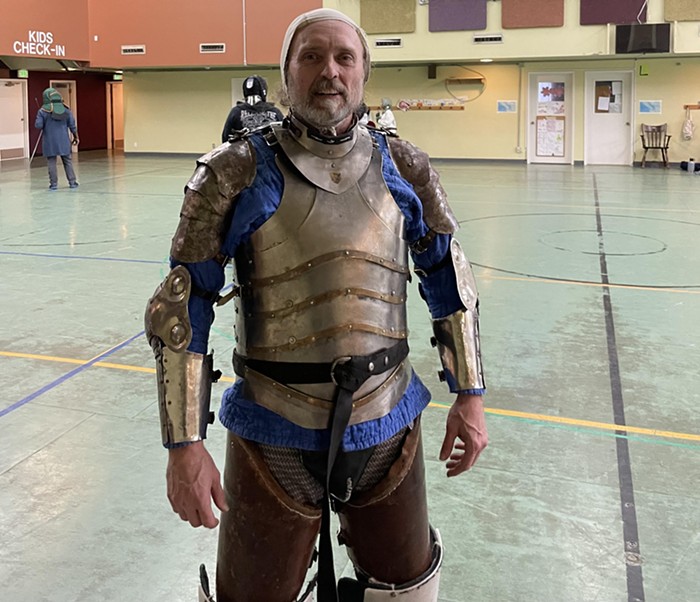
Often, real life can influence an SCA persona or a field of study. Sisco/Gangolffin told me about a woman in the barony who rooted her SCA focus in Mesoamerican history. While pregnant, she researched Mesoamerican midwifery and implemented some of the learnings in her pregnancy.
“We are really doing this as living archaeology for ourselves, not for an audience,” Sisco/Gangolffin said.
Nicolin and Nicole
Nicole Ricca sat on the gym’s bleachers sewing a modern dress based on a 13th century Finnish construction. She’s also Nicolin Bray, an early 14th century widowed London wool merchant.
“I made her a widow because then you can be in control of everything,” Ricca/Bray said. You’ll find a lot of widowed personas in the SCA since history didn’t allow most women much agency. Widows can own their own businesses and control their own money. The SCA isn’t that stringent about historical accuracy, though Ricca/Bray enjoys that aspect the most.
“My geek is doing history,” Ricca/Bray said. She grew up wanting to be an archaeologist, but went into tech because she felt she had to support herself.
Ricca/Bray discovered the SCA with her husband 24 years ago while living in North Carolina. The two heard about the group from friends on a multi-user dungeon video game.
“I was working at IBM doing software testing, and [the SCA] was just a break from being in a room with a bunch of servers,” Ricca/Bray said. “So all week, I just did numbers and tech and whatever. And on the weekends, I could dress up in a pretty dress and hang out in a camp and tent with candles and people playing medieval music. It was just a fun escape.”
Part of the fun is the variety of the SCA.
“It is a hobby within a hobby,” she said. She picked up pattern-making, weaving, cooking, and she even tried out fencing (her husband’s main SCA interest) for a while.

Being able to share those interests is another big highlight.
“I can also go and info-dump on people and just be like, ‘Oh my gosh, I found this Bronze Age bog burial that I'm really into, and I'm going to sit here and tell you about it for an hour,’ and there were people in this community who were also excited,” she said. “That has not happened anywhere else.”
Other re-enactment groups use much narrower scopes. For instance, Ricca/Bray once spent a year and a half in a small group focused on 1582 London. As you can imagine, the play with 1582 London became too limited. She prefers SCA's much broader scope.
“I could do Bronze Age. I can do Roman. I can go and do anything I really want to,” she said. “If you wanted to be a little more fantasy-oriented, you could do it. If you wanted to romanticize a little more, you could. If you just want to use this furnace made by hand out of mud and do glass-blowing in the hardest way possible, you can.”
There’s something for everyone in the SCA. Sometimes, the thing people find is love.
Gera and Jeri
Before Jeri Sisco became the widow Gera Gangolffin, she became a widow in real life. In fact, she only joined the SCA because her husband of 13 years died in 2009. She lost him and the life they shared, so she had to reinvent her life, find a community, and expand her social circle.
At the recommendation of her sewing class peers, she visited an SCA faire on the Olympic Peninsula with her sister. They ran into her sister’s high school ex-boyfriend, who happened to be fighting in the faire’s tournament.
“He literally stopped fighting and withdrew from the tournament to show us around and explain things,” Sisco/Gangolffin said. She joined Madrone at the earliest opportunity.
Then, after a few years, she fell in love.
“We were part of the same small group that camped together,” Sisco/Gangolffin said. “And, because we were the two single people, we got put in the same corner. We were really good friends for a long time. We drove carpool to events together and all that.”
On the drive back from one event, dressed in their period garb, the two realized the day they’d spent together felt like a date. They decided to go on another more official date—this time in the 21st century.
Now, they’ve been married for five years. The two of them run Madrone as Baron and Baroness (or, Barun and Barunin, since their personas are German). She described their roles as “pastors of a small church with no religion.”
Really, Sisco/Gangolffin hadn’t been looking for love.
“I was more looking for people, for community,” Sisco/Gangolffin said. “And, that's what I love about this. It's a really tight-knit community. So many of the people in this room are personal friends. We camp together, we carpool together, we get together on weekends to go to movies, occasionally.”
Odette and Tessa

Tessa Gokce, 28, joined SCA within the last year. She’s generally younger than everyone else. The demographic skews, appropriately, middle-aged. In the SCA, Gokce’s known as Odette von Sachsen d'Alsace, a Transylvanian in the “12th century-ish.” She showed up to fighting practice in a red-trimmed black doublet, matching pants, and a red-hooded cape.
“People are just amazing here,” she said. “If you show dedication and interest in the game, the sport, all of it, it is possibly one of the most supportive communities I've ever been a part of. People will be there for you and cheer you on and encourage you and lift you up.”
She received the clothes she wore from an SCA member.
“The guy I was just fighting—that guy over there in the green,” Gokce/von Sachsen d'Alsace said, pointing across the gym. “He's my teacher, and he made all this for me. He made it by hand—hand-sewn—so I'd have something to wear, to fight in.”
He actually made her two doublets and pants to match.
The group’s support and guidance helped her achieve a dream of fighting, which she practices three to four times a week. As a small woman, fighting “heavy” in full armor is no easy task, yet Gokce/von Sachsen d'Alsace recently placed second in a tournament where she was the only woman.
“In my past, I would give up on things a lot. Because everyone's so supportive here, it's like I can't make excuses. The only thing standing between me and succeeding is myself," she said.
Attending Athenaeum
To really grasp all the things people do in this hobby, I attended Madrone’s Athenaeum, a showcase of arts and science from throughout the kingdom held at Lake Washington High School. Fully dressed up SCA members displayed their research into things such as riderless horses, Viking-era forge bellows, and 11th to 20th century European women’s letter-writing. Others showed off handcrafted period hats, ruffle collars, and recreations of Roman workshops. One woman, a falconer, brought her falcon named Ollie.
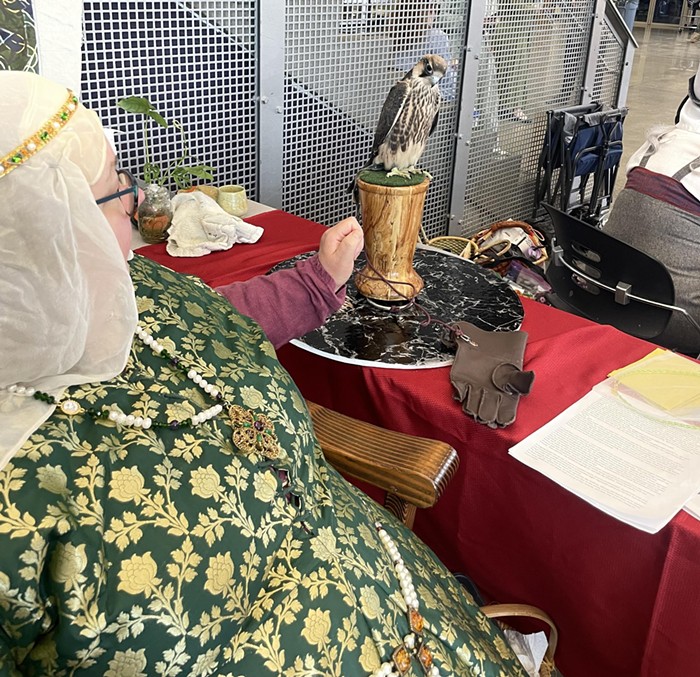
For the event, Joel Reid, or Aeron Corrino as he's known in the SCA, decked me out in Roman-style linen tunics. Reid/Corrino, a costume designer, wore a glittering black and gold tunic cinched at the waist by several tassels, a thick, multi-jeweled skull necklace, and a yellow headscarf held down by a metal crown. Most SCA players have multiple costumes for their personas; airy Roman garb for the summer, something different for autumn, and what Reid/Corrino called “pretty, pretty princess attire” for the kingdom’s winter gala. He went “totally for Moroccan” because he knew how hot this event could get. Sneakers poked out from underneath his robes.
“It’s like a greenhouse in here,” Reid/Corrino said. “I'm like, yeah, no, I'm not wearing any of the heavy duty Elizabethan stuff. I would die, fainting in my own juices.”
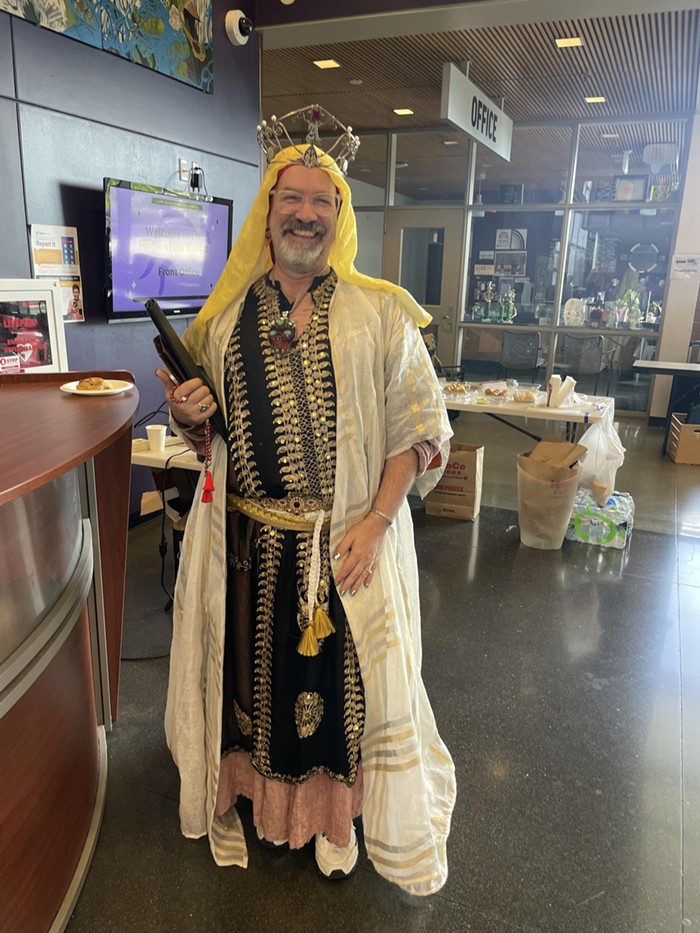
Clothed in my starchy linen and feeling less like an outsider, I met up with Sisco/Gangolffin. She wore a hand-stitched yellow dress. Two braids looped under her coronet.
In the high school’s hallway, we waited for the King and Queen of An Tir.
The kingdom crowns its royalty via crown tournaments. The winner of the tournament is crowned, and the person they fight for—their consort—is crowned alongside them. The crown is the main bit of theater in the SCA; people show deference to royalty.
As King Ulfgar Thorvadlsson and Queen Juahara al Azin (aka operating room nurse Richard Keffeler and his wife, glass bead artist Kerri Fuhr-Keffeler, respectively) passed, people inclined their heads. I curtsied, feeling a little thrill as Fuhr-Keffeler/al Azin offered me her hand.
Ulfgar and Richard and Juahara and Kerri
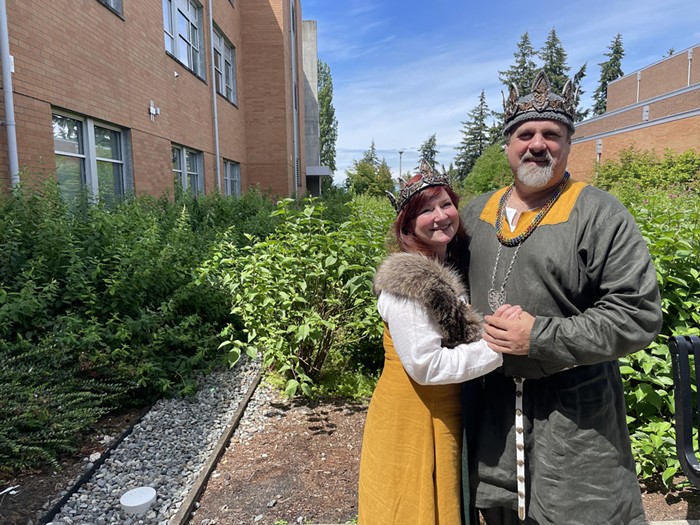
Keffeler/Thorvaldsson and Fuhr-Keffeler/al Azin also met and fell in love through the SCA.
“There is magic always,” Fuhr-Keffeler/al Azin said, “especially [camping] in the evenings, when the fire light is going and the torches are lit, and you look up and there's stars in the sky and a full moon and people are singing.”
Fuhr-Keffeler/al Azin, a lifetime lover of fantasy novels and dragons, started in the SCA when she was 18. Now, at 53, she’s queen thanks to Keffeler/Thorvaldsson.
As a fighter for nearly 30 years, he’s fought and won every tournament he's wanted to win except one, and for the 26 years they’ve been married, he's done so in Fuhr-Keffeler/al Azin’s honor. “It makes my heart go pitter patter,” she said. The only tournament he hadn’t won? The crown.
Keffeler/Thorvaldsson finally claimed victory in September. When he entered the tournament, something felt right. He remarked on it to the person next to him.
“I said, ‘You know, my armor feels great today. It’s not pinching, it's not binding, it feels light as a feather,’” Keffeler/Thorvaldsson said. “It carried me through the entire tournament.”
Winning was literally a crowning achievement.
“It really meant a lot to me personally, as a goal, but it also meant the world to me to win it for her because that's the ultimate gift in our society," he said.
The foundations of the society are honor and chivalry, he explained. That extends beyond how people interact with their romantic partners.
“If you do something nice for somebody in the society, they almost immediately reciprocate it,” Keffeler/Thorvaldsson said. “That’s because your word is your honor and it means everything.”
He depends on people in the SCA. These are the people he calls when he’s broken down on the side of the road, they’re the people who help him move.
“Just today, we pulled in here and my tire was flat on my truck,” Keffeler/Thorvaldsson said. “Two of the knights took my truck and got it fixed. Not just because I’m king, but because they knew I would have done exactly the same thing for them.”
The Kingdom of Geekdom
I ate a Venetian-style medley of foods (sausages, quiche, ricotta, berries, olives, et cetera) inspired by an early 15th century manuscript for lunch. Seated in the courtyard alone, I watched groups of people dressed from different eras break bread together.
Observing the intricacies of their creativity and their friendships made my heart swell, then ache. I missed being a geek, and I missed my geek friends.
In particular, I used to participate in an annual scavenger hunt with a team of 14 other people I met online. The items were prompts designed to test creativity and challenge comfort zones. We completed items by uploading picture or video proof to the hunt’s website. For one week each year, my team and I stayed up until all hours crossing items off the list—things like “show us a picture of a literal bull in a china shop,” or “play ping pong underwater.”
For seven summers, we ideated together and utilized each others’ unique skillsets; we boasted painters, photoshop whizzes, people with access to horses—all the necessities. We celebrated any wins (sending a message into space was a big one), and solved any mishaps, like when we could only find a calf to put in the china shop.
I went to their weddings. I stayed at their houses and hosted them at mine. Then, during the pandemic, depressed and spent, I couldn’t summon any creativity for the hunt. I failed to deliver on my assigned items. Quietly, I disappeared. I lost touch. By the time I was ready to try again, the scavenger hunt folded. Now, I watch as their lives go on without me, and I miss the way I felt creative with a group of eccentrics I’ll never know the likes of again.
Except, seeing the SCA at work reminded me of that group of weirdos. It also showed me that those kinds of people are everywhere, and the world is not lacking in unfettered passion and creative joy. I could find it again, if I only tried.
